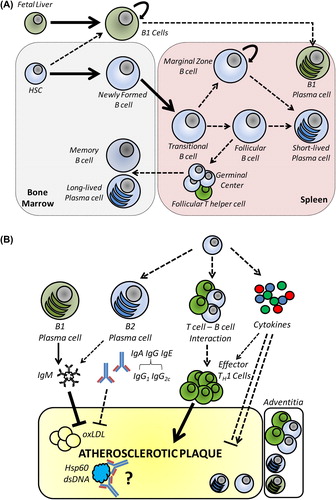Figures & data
Figure 1. A: B cell development and subsets. B1 cells develop primarily from fetal liver and self-maintain in the adult. B1 cells are the source of natural IgM antibodies that target antigens such as oxidized phospholipids. B2 cells develop from adult bone marrow stem cells and undergo a series of differentiation steps in the bone marrow, then leave as immature/transitional B cells and further differentiate into either marginal zone or follicular B cells in the spleen. B2 cell activation leads to short-lived plasma cell differentiation or, in the case of T cell-dependent responses, germinal centre formation, which results in affinity maturation of the B cell clone and formation of memory B cells and long-lived plasma cells, which can persist in specific bone marrow niches until antigen re-encounter. B: B cell regulation of atherosclerosis. Natural antibodies and other IgM targeting oxLDL, primarily but not exclusively from B1 cells, are thought to be atheroprotective. The potential pro-atherogenic functions of B2 cells include production of IgG2 antibodies that activate macrophages via Fc receptors, activation of pro-atherogenic Th1 CD4 T cells, or production of pro-inflammatory T cells. B cells may act remotely from peripheral lymphoid organs or locally from the adventitia and atherosclerotic plaque.

